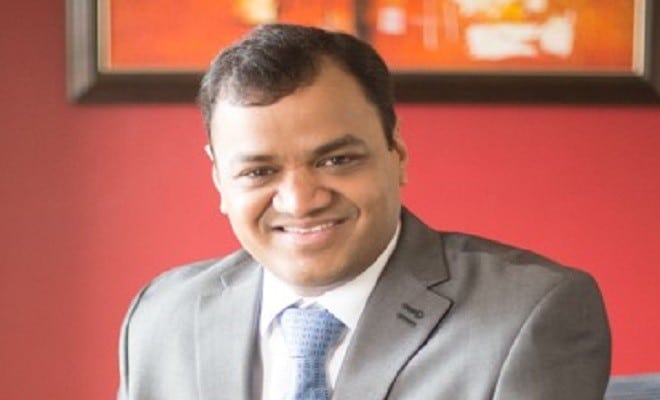NXP Semiconductors is a provider of secure connectivity solutions for embedded applications. The organization with its end-to-end IoT portfolio, deep application insight and partner ecosystem, specialises in providing cutting-edge solutions. NXP Semiconductors is driving Internet of Things (IoT) innovation in the secure connected vehicle, smart connected solutions, and end-to-end security and privacy markets.
Sanjay Gupta, Vice President and Country Manager, NXP Semiconductors, spoke to EFY Network and shared his views on the current state of IoT in the country. He believes that security will be the foremost important area in deployment and evolution of IoT.
Here are interesting excerpts from the conversation
Q. What three technological trends will lead the evolution of IOT in India?

The three technological trends that will lead the growth and evolution of IoT include three buzzwords – smart, secure and connected.
Smart – We are moving towards an era of technological revolution and the innovations in semiconductor technologies are leading this revolution. Add to this the processing power of smarts devices that has gone multi-fold. What we could only imagine in the past is now possible because of faster and better processing rates. I remember, when I was in college, nearly 25 years ago, we had ideas, but were restrained due to slower and non-smart processing.
This brings us back to the first mega technological trend, which is smart and has fast processing power. And this trend is also driving leading semiconductor companies across the world to invest in development of smarter processing units.
Connections – We are entering a world where eventually all devices will be connected to each other. A lot of advancement is happening around this mega trend in IoT. Whether it is NFC, low power Bluetooth or Ethernet, seamless connectivity will be the foremost domain to define the growth of IoT. In a nutshell, the evolution of IoT is greatly dependent on the speed at which connections transfer commands and data from one device to another.
Secure – However, this evolution of IoT will regress if security of connected devices and user information is not ensured. A data leak will not only lead to major financial losses, but also pose serious threats to human life. It will not be wrong to say that without state-of-the-art security solutions, everything encompassing IoT will just look good on paper.
Q. What about artificial intelligence (AI) and machine learning? Will these too witness a huge boost in the future?
IoT is only possible because of evolution of these technologies. AI is nothing but embedding cognitive thinking in a machine and training it to think, decide and act like humans. To put it in simpler words, this training process is similar to how we nurture and train our kids when they are growing up. In the same way, AI has its own network of connected nodes and arcs that it uses to learn and improve. AI and machine learning are something that define the sense, think and act actions of IoT or connected devices.
To elaborate further, and as I often say, AI is equivalent to the human brain. The only difference being that evolution of AI through machine and deep learning will be much faster than the evolution of the human brain. For example, a few researchers once developed an algorithm to train a machine to identify the snow dog, Husky. However, owing to the dog’s fur and snow backdrop, the machine confused the dog with a wolf. But with additional algorithms the machine learnt the difference rather quickly and that scenario changed. Today, AI and machine learning are evolving at a much faster pace. The future of IoT will belong to algorithm developers, who have the ability of develop and put in place a set of smart and self-learning equations. So, the future is already here, and we are already witnessing a new wave of revolution in AI and Machine Learning.
Q. Can you name three technologies shaping the future of IoT in India?
AI is the biggest game changer. Everything in IoT, in one way or the another, is driven by AI. The smarter the AI, the smarter and better are the decisions. You may probably see two devices of same length, size and components, but the levels of smartness of AI will always define the real difference in them. A great example of these would be different smart speakers available in the market today. The one that sells the most is most probably smarter than the other.
Security technologies – No matter how smart your device’s AI is, unless it is completely secure, it would not be able to make a real difference and a threat of data loss will always be in question.
Two years back, a big news broke, hackers were able to enter inside the infotainment system of a car. I must tell you that entering just the infotainment means access to the eco-system of an autonomous car. This can prove to be fatal. Not only, can they decide where the car goes, they can eventually use it as a weapon as well. This is where security technology in IoT steps in. That was the major hint for the whole IoT industry. Research and development on security technologies, since then, has increased at a geometric rate.
I must add that NXP leads the industry in the security of autonomous vehicles. We have five points of security at the movement, and hacking in even one of those, is next to impossible.
Safety technology – The levels of safety technology in automotive cars are generally referred to as ISO 26262. It is a very famous buzzword. Imagine you have two chips of exactly same performance capabilities, then the safety technology defines how good the chips really are. It is simple to explain – no matter which smart device you use, it must never pose any threat or danger to human life. These are also defined by the ASL levels of security.
Q. How ready is the Indian tech eco-system to develop and deploy these in the coming times?
Whenever we talk about deployment and use of virtual technologies that do not need infrastructure, India will never lag behind. The best example of this is the mobile coverage in our country. We have more than a billion active phones in India already. India has 25 per cent of world’s connected population. So, to answer the question, India will not lag behind other nations in terms of technology.
Q. Do you foresee India coming up with its own IP or branded solutions in IoT arena?
We have only explored the tip of iceberg that encompasses IoT. Considering the pace at which our technologies are evolving, by 2020 we will have nearly 100 billion connected devices that would produce nearly 50 zeta-byte data per day. Today, as we are still working on an eco-system to store and support this size of data, India has a unique opportunity to be a part of this revolution.
India missed being part of the first industrial revolution, but we should not miss this opportunity. We have already become the 6th biggest economy in the world. Our population will prove to be our biggest asset in the future. Being young, we will consume and produce more data. There will also be a lot of dependency on governments, private organisations and other agencies.
Q. Do you think lack of standards will affect the IoT industry in India?
The entire IoT ecosystem is based on big data. The standard of security and data authorization will play a critical role as we go forward. What if any app accesses your bank account details and debits money out of it? This is where the standards, both in terms of legislation and access, come into the picture.
India can lead in defining the standards of security in IoT. Like I said before, each device is going to connect to one or the other and generate massive amounts of data. This is where cloud computing and storage will play a key role. Storage of big data will only be possible with cloud and each cloud would have its own set of rules. There is also a strong probability that these clouds will also interact with other. This is where the standards step in. However, a lot of legislation on how these devices interact with each other will be required to ensure privacy. We will also need to define ethics in IoT. The difference between ethics and legislations will be a tough nut to crack though.
Q. What’s your view on the present state of security in the IoT domain? How do you see them evolve from here?
Today, no smart devices or connections other than mobile payments and e-government passports are completely hack proof. Let me give you an example to illustrate this, a casino in Las Vegas deployed a smart fish-tank that used IoT to feed the fish. A group of hackers did, hacked the fish-tank and used this as a loophole to enter the casino’s cloud eco-system. Needless to say, the hackers remotely looted the casino’s account.
The message here is that one entry point can lead to loss of critical financial information as well as human life. Having said that, I would like to emphasize that security is going to be the most essential part of IoT. However, we have a long way to go before IoT becomes completely hack-proof, and I am sure that NXP will be among the front runners and lead that era.










